Light pollution: how artificial light threatens nature (and us)
By Greta Solbrig on April 16, 2024 in Blog
Stars illuminating the night sky signal rest for diurnal species and play for nocturnal ones. But do artificial stars have the same effect? The short answer is no.
Human activity is responsible for a wide array of pollutants, so thinking of less concrete forms, such as excess light, may seem trivial. But light pollution is a global issue that creates much larger problems than you may think.
Circadian rhythms are bodily cycles that roughly adhere to a 24-hour schedule, at least in the case of humans. These rhythms provide important signals to your body, altering appetite, alertness and more. But how are these bodily rhythms kept in check?
Humans today have strictly curated their lives to a schedule that, for the most part, is easy to follow. The issue is that even the best planners are subject to disruptions when the circadian rhythms are thrown off. One of these major disruptors is light exposure.
While the darkening night sky would normally signal sleep for your body, bright, fluorescent light curbs melatonin production, keeping you awake when your body needs rest. Even blue and LED light can have this effect, and declines in natural melatonin production have been connected to various physical ailments and even cancer.
While light pollution is detrimental to the human body, we must not ignore the effects it has on our ecosystems. Just as we rely on natural light-dark cycles, so too do almost all types of animals. Braving some of the worst disruptions are the nocturnal species that we know and love. Animals built to hunt at night can be disoriented by the glare of city lights, and while diurnal species add time to their day, nocturnal species lose it.

Common Nighthawks (Chordeiles minor) are impacted by light pollution both during their migration and during their active hours. Nighthawaks winter in Central and South America and are nocturnal. Keep an eye (and ear) out for these birds during summer nights. There buzzing 'peent' call is a common sound of summer. Photo by Larry Reis
Moreover, circadian rhythms in animals can more severely alter important behaviors. Humans do not necessarily rely on circadian triggers for reproduction and migration, but most animals do. Migratory birds especially rely on seasonal change for proper migration patterns, but excess light can alter timing and direction of flight, even leading to collisions with one-another mid-air. Another prime example is the hatching of baby sea turtles. In their tumultuous quest from beach to open ocean, hatchlings look to the horizon line lit above the water for direction. But the accumulation of florescent lights in beach front cities are powerful enough to easily redirect the hatchlings, exposing them to confusion and prolonged threat of predation.
From human health implications to predator-prey interactions, light pollution is a global issue that should be met with the same urgency as other pollutive practices. Without proper management and mitigation, threats to already endangered species may be exacerbated and prove to be yet another barrier in safeguarding our wildlife. It can be hard to comprehend the severity of issues we have become so accustomed to, but through a simple search of global satellite imagery, one can truly grasp the breadth of this issue.